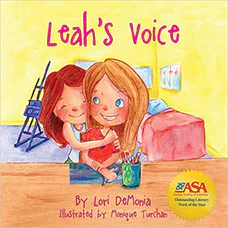Leah’s Voice
Written by Lori Demonia
Illustrated by Monique Turchan
28 pages
•
Published 2012 (Halo Publishing International)

Recommended Age Range: Kindergarten through 3rd grade.
Publisher's Summary:
Leah’s Voice is a story that touches on the difficulties children encounter when they meet a child with autism or special needs. Siblings may find it hard to explain to their friends, or feel disappointed when others aren’t understanding. This book tells the story of two sisters facing these challenges. Through her kindness and devotion, one sister teaches by example the importance of including everyone and showing acceptance.

Dr. Annie's Takeaways
Recommended for: This book is great for the siblings of autistic girls, who are very underrepresented in children’s literature about autism. It validates the challenges of having an autistic sibling while highlighting love and connection between the siblings. It particularly supports conversations about what to do if a friend rejects an autistic sibling and presents a model of what inclusive play might look like. The book explicitly states that Leah is “autistic.”
Would a child like it? This book would likely be validating to a child with a sibling like Leah, especially if they have had the experience of a friend saying something hurtful about their sibling.
Evidence-Based Practices:
Psychoeducation
Tone: Validating, explanatory, reassuring
Story Quality: This story isn’t particularly artful, but it is a sweet, much-needed book about an autistic girl, and it is an excellent conversation starter to help children navigate hurtful comments from peers about their autistic siblings. Parts of the plot are vaguely unrealistic in that everything gets resolved quickly and neatly, but it’s ultimately hopeful and, I believe, helpful.
Illustrations: Cartoony, brightly colored watercolor illustrations
Representation: Logan is a White non-autistic girl with an older sister, Leah who is described as “autistic” and “on the spectrum.” Leah has challenges expressing herself verbally, has sensory sensitivities (she covers her ears in the grocery store), and she is a talented artist. Logan has a playdate with a friend, Abby, who is also a White girl. Logan and Leah have a Mommy and a Daddy.
Psychological Practices: This story validates different feelings that siblings of autistic children often have (love, frustration, confusion), and it provides an explanation of autism (“It makes it hard for Leah to talk to us, and sometimes things upset her that wouldn’t upset you, or me…It’s not something that will go away. But we see Leah handling things better all the time…. And we can try to see the world a little like Leah does.”) The story also models how to manage a friend saying hurtful things about an autistic sibling, as well as how a friend can be inclusive of an autistic child (i.e., by being open to how they like to play and not insisting that they play in a specific way).
Concerns: None
